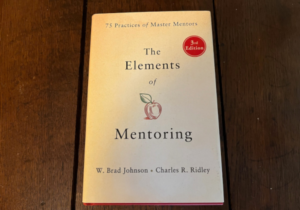Toward Institutional Progress: Faculty Book Groups, Anti-Racist Texts
By Eric Sentell (PhD) and Jessica Sentell (MPA)
 Progress toward diversity and inclusion can begin with individuals in the institution coming together to educate themselves and reflect on their practices from an anti-racist perspective. Participating in faculty book groups studying anti-racist texts is a simple, actionable idea for driving institutional change.
Progress toward diversity and inclusion can begin with individuals in the institution coming together to educate themselves and reflect on their practices from an anti-racist perspective. Participating in faculty book groups studying anti-racist texts is a simple, actionable idea for driving institutional change.
Background
During the 2018-19 academic year, we participated in a faculty book group that met monthly to discuss anti-racist texts. After each discussion, members submitted a written reflection about applying what we learned to our teaching, service, and professional development. Participation was encouraged by University leadership and incentivized with a Certificate in Culturally Responsive Teaching. The Certificate could be earned through a variety of professional development opportunities, and the book club and written reflections fulfilled most of the required hours.
In the fall semester, we read an anthology of essays on anti-racist pedagogy, Everyday Anti-racism. In the spring, we read Robin DiAngelo’s White Fragility. The group was facilitated by a Black female faculty member and the White female director of our university’s faculty development office. The university and its local community are predominately White, and the book group reflected this racial make-up.
At our first meeting each semester, we discussed the ground rules for our discussions, the reading schedule, and the written reflections required for earning the Certificate in Culturally Responsive Teaching. Later sessions provided invaluable practice discussing racial issues and reflecting on how to become more anti-racist in our institutional and social contexts.
Below, we share how these experiences shaped our practices and pedagogy. Institutional change requires, and can be most easily begun with, such individual changes.
How the Faculty Book Group Challenged and Changed Us
For Eric, the book group challenged fundamental assumptions underlying his pedagogy as well as some attitudes that he didn’t realize were problematic.
At one of the first meetings, for example, Eric explained how he balances respecting students’ cultures and languages while still teaching standard written English. He gave this explanation in a context of hair styles and clothing, relating using “effective language” for one’s audience and purpose to wearing “effective” hairstyles and clothing. The Black woman facilitating the group asked, “But this is my hair. Who is anyone to say it’s ineffective?” Immediately recognizing the problem, Eric said the definition of “effective” must be expanded to include alternative choices.
In one of the spring meetings, Eric expressed the dilemma of teaching writing with an anti-racist approach. “Do I accept African-American Vernacular (Ebonics), knowing it won’t fly in a professional setting, or do I force students to subjugate their language?” Eric had always taught “code-switching,” but he learned that students could tell which code was preferred.
A colleague described how she taught language as “socially-situated,” meaning any dialect could be more effective, appropriate, or natural in a given social situation. Thanks to this response, he decided to teach the dominant discourse while emphasizing it is just one of many options and not inherently superior, truly empowering students to choose for themselves.
Throughout the book group, Eric also realized how certain attitudes were more problematic than he realized before someone engaged with them. For instance, he mentioned a California Supreme Court decision to allow questions about the O.J. Simpson trial during jury selection. He referred to a poll showing a dramatic shift in Black views of Simpson’s innocence post-1995 and suggested that the question could, in fact, be a proxy for bias.
The lone Black man in the group pointed out that every Black person knew someone with a story of police abusing their power, and that was likely what Black people were responding to when asked about O.J. Simpson’s innocence, especially circa 1995-96. Without such experiences at the book group, Eric would not have realized how some of his attitudes might reflect a narrow, White viewpoint that ought to expand.
For Jessica, the studies were equally transformative both pedagogically and in terms of challenging underlying assumptions and understandings. She, too, had to confront the topic of code switching in academic writing. This wasn’t a problem she has encountered on a large scale as her courses do not contain as much writing, and the writing her students complete is in the form of reflection-type assignments, usually considering their own political values, socializing influences/experiences, and so on. Upon rumination, she determined that reflections are supposed to be just that — a reflection of one’s own thoughts and ideas.
Thus, she concluded that as long as a student’s thoughts are logical, readable, and on topic, code switching outside of formal academic language is not an issue on these assignments. In fact, she would wonder if the student was really “reflecting” if they were not speaking in their own preferred variation of language. However, she acknowledges that if she were assigning a formal research term paper, she would likely have different, more formal expectations.
In his teaching, Eric went from avoiding racially sensitive topics when they arose to engaging them with the language and empathy he learned and practiced in the book group. In spring 2019, for instance, the MAGA-hat wearing students of Covington Catholic High School became embroiled in a national controversy for their encounter with a Native American Vietnam veteran, Nathan Phillips. The subject came up multiple times in one of Eric’s classes even though the class discussion didn’t directly concern the incident.
He commented on the problem of systemic racism, highlighted his privilege as a straight cisgender White male, and described how he could be described as a racist and sexist for participating in systems benefiting him. A few class periods later, having been encouraged to seek feedback from People of Color by Robin DiAngelo, he asked the class’s lone Black student for feedback and she expressed appreciation for him speaking up as well as what he said.
Since then, Eric has taught other Black students, including during the abbreviated semester of spring 2020. When these students had more difficulty with the transition to remote delivery than the White students, Eric remembered what he had learned about inequitable access to wealth, technology, internet, and support systems, and he went to extra lengths to support their learning rather than viewing them as less capable or responsible than his White students.
In the classroom, Jessica also became more confident addressing and allowing even more discussion of racially sensitive issues. Because she teaches government, issues of race and inequality are frequent topics. During one of the book group sessions, the question was posed: “Do you push the issue of race in your class?” Jessica instantly thought, “Yes!” Because she teaches government, she feels it is extremely important to bring to light how different policies affect various populations and how a lack of diversity in government leads to experiences being overlooked or even intentionally excluded.
One example where this becomes clear to students is when discussing the lack of representation in Congress. Many times, the majority of students are visibly surprised when Jessica shows them pictures and gives statistics on the sociological composition of Congress. In racially diverse classes, she usually gets a quick reaction with students recognizing the lack of representation and diverse perspectives. In less racially diverse classes, however, many times she is pleasantly surprised by the number of students who recognize the lack of representation and suggest how to fix the problem.
She has also worked on finding more entry points into addressing race in the classroom. She has found that she can turn a conversation about the freedom of speech, for example, to hate speech and/or the idea of Neo-Nazis versus Black militant groups using free speech (and everything in between). She leads students to discuss the legality of such speech, as well as the implications and values behind their beliefs.
Similarly, when talking about participation, partisanship, and voting patterns, she makes sure students understand that we cannot ignore the effects race has on both participation in the political process and voting itself. She now takes the discussion beyond pointing out the voting and partisanship patterns, and implores her students to address the “why?” Why do we have such significant differences in turn out (sometimes 20-25% different) between racial groups? Is this a problem? What, if anything, can we do to change these patterns? Why should we attempt to change these patterns? What impacts do these statistics tell us about the status of democracy in our nation?
When discussing the implications for democracy, she also points out that both Blacks and Hispanics vote at higher rates in states that have Black and Hispanic elected officials, making the point that inclusion and representation are key to participation and that we have to be aware and vigilant of the impacts race has on all decisions, as well as the implications all decisions have on various racial groups (and other minorities or socioeconomic groups).
Jessica also had to reflect on what she had learned about inequalities in wealth, healthcare, technology, internet, and support systems during the COVID-19 pandemic during the spring 2020 semester. Jessica had more Black students encounter difficulties with the semester, especially with missing class Zoom sessions or assignment/test deadlines due to family members falling ill or passing away. Like Eric, she intentionally tried to support the students’ learning rather than viewing them as less responsible than the White students.
Suggestions for Implementing Faculty Book Groups
At our university, the office responsible for providing on-campus professional development coordinated several book groups on various themes. They provided the books free of charge, arranged a meeting space, and recruited facilitators.
Such an effort could be replicated at the college or department level, and faculty members can also organize their own book group.
The main challenge is to facilitate the group. Our facilitators established a “judgment-free zone” from the beginning, making it clear that everyone was present to learn and do better, that mistakes would be made, and that no one would be condemned because of them. Creating this attitude of mutual trust is essential to effectively implementing an anti-racist book group.
Suggested Texts for Faculty Book Groups
Multitudes of anti-racist books, novels, films, and online resources exist, and numerous media outlets offered detailed lists of such resources during the national protests sparked by George Floyd’s murder. Rather than recreate yet another comprehensive list, we will recommend resources that may be especially useful in a faculty book group.
Everyday Anti-Racism: Getting Real about Race in School edited by Mica Pollock
This anthology contains essays from K-12 and college educators, each recommending an anti-racist strategy.
White Fragility: Why It’s So Hard to Talk to White People about Racism by Robin DiAngelo
Robin DiAngelo’s slim but dense book captures the difficulty most White people have discussing racial issues, and both challenges and equips readers to overcome it.
I’m Still Here: Reclaiming Black Dignity in a World Made for Whiteness by Austin Channing Brown
Austin Channing Brown highlights the ways that White workplaces can harm People of Color. Brown’s voice enchants, and her story engenders empathy for people who struggle to understand how racism affects people day to day.
Why Are All the Black Kids Sitting Together in the Cafeteria? by Beverly Daniel Tatum
Beverly Daniel Tatum, a distinguished psychologist, offers a heavily researched but accessible, engaging discussion of racial identity formation that benefits both teachers and parents.
Between the World and Me by Ta-Nehisi Coates
Coates’ National Book Award winning memoir offers a poignant reflection on his experiences as a Black man in America.
Stamped from the Beginning by Ibram X. Kendi
The subtitle says it all: a “definitive history of racist ideas in America.” Kendi won the National Book Award for this work.
How to Be Antiracist by Ibram X. Kendi
Kendi argues for transforming from being passively racist and accepting the racial status quo, to becoming actively antiracist and challenging the status quo.
TED Talks, How to Be Antiracist, Ibram X. Kendi
Kendi summarizes his argument for being actively antiracist in the context of 2020’s events.
The Hate U Give by Angie Thomas
Starr Carter must decide whether to come forward as the lone witness in the police shooting of her friend while also navigating her Black urban neighborhood and all-White private school.
Hosted by journalists of color, this podcast offers “fearless conversations about race” and “how it impacts every part of society — from politics and pop culture to history, sports and everything in between.”
NPR’s Hidden Brain podcast, “The Air We Breathe”
Using interviews with various researchers, Hidden Brain explains implicit bias and its implications for criminal justice, police violence, and society.
NPR’s TED Radio Hour podcast, “Confronting Racism”
Adapting TED Talks about (anti)racism, this podcast episode features potent explorations of the costs of racism.
NPR’s TED Radio Hour podcast, “Ingrained Injustice”
Another set of TED Talks challenges preconceived ideas about racial justice.
Slate’s What Next? podcast, “A Politician’s Brush with NYPD Abuse”
The host, Mary Harris, interviews a Black New York state representative who found himself caught up in a violent police response to a peaceful protest. He also shared his experiences as a Black man and politician working for change.
A nonpartisan think tank, PEW offers a multitude of statistical reports, typically breaking the statistics or surveys down by race, ethnicity, gender, and more. These reports can provide conversation starters and context.
Eric Sentell teaches writing and rhetoric at Southeast Missouri State University. He is an Edge for Scholars blogger as well as the author of How to Write an Essay like an Equation and Become Your Own Fact-Checker. Learn more at www.ericsentell.com.
Jessica Sentell teaches political science and government at Southeast Missouri State University. She is a former Presidential Management Fellow with experience at the Department of State, the Department of Defense, and the Drug Enforcement Administration.
Related Resources:
Civil Discourse as a Path to Hearing Others’ Hopes & Fears
Gender Equity and Opportunity in the Pandemic and Beyond
Supporting Diverse Communities during the COVID-19 Pandemic
Home Page ImageCreator: Tim Mossholder on Unsplash
Source: https://unsplash.com/photos/zs-PAgqgenQ





0 Comments